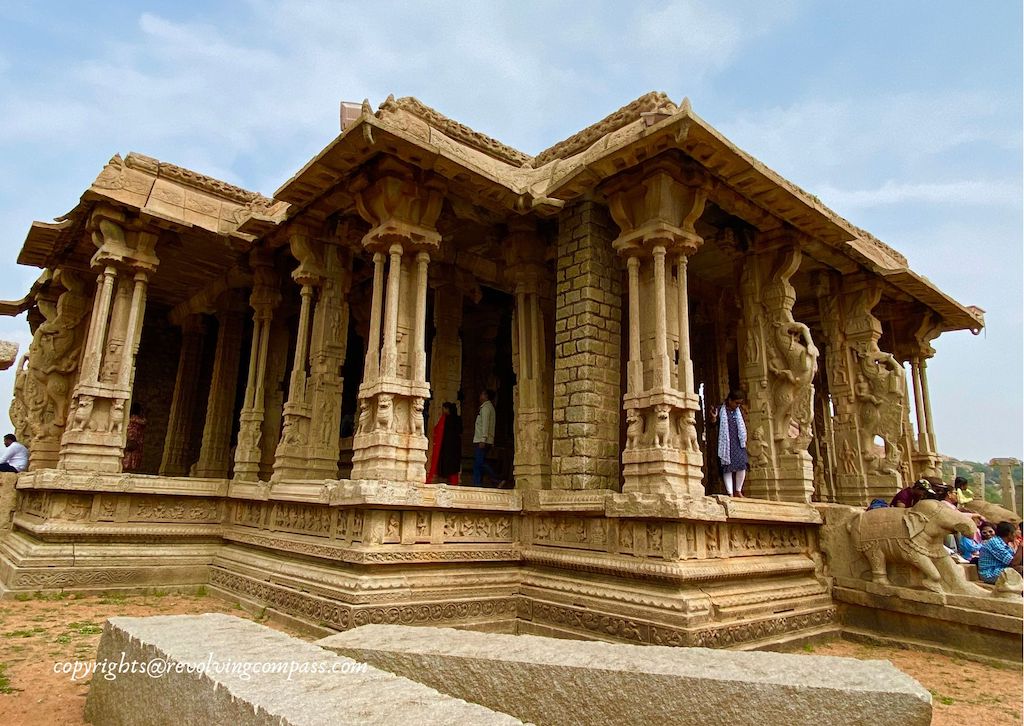Of all the grant structures that stand tall through the ruins of the once glorious Vijayanagara Empire – the second most prosperous empire of it’s time in the world – Vijaya Vittala Temple is no doubt the most magnificent and the most outstanding. Also the most entirely intact structure. And yet, I missed visiting it on my first trip to Hampi!! Can you imagine that? With the hot weather typical to this arid region and a few months old baby in my lap, I really couldn’t make much of my time in Hampi on my first trip to this area. So, when my second trip to Hampi realised, my clear goal was to explore Vijaya Vittala Temple completely.
After having fulfilled my goal, today I take you with me on this virtual tour of the Vijaya Vittala Temple. And also provide all the information required for you to visit here.
Table of Contents
An introduction to Vijaya Vittala Temple Hampi
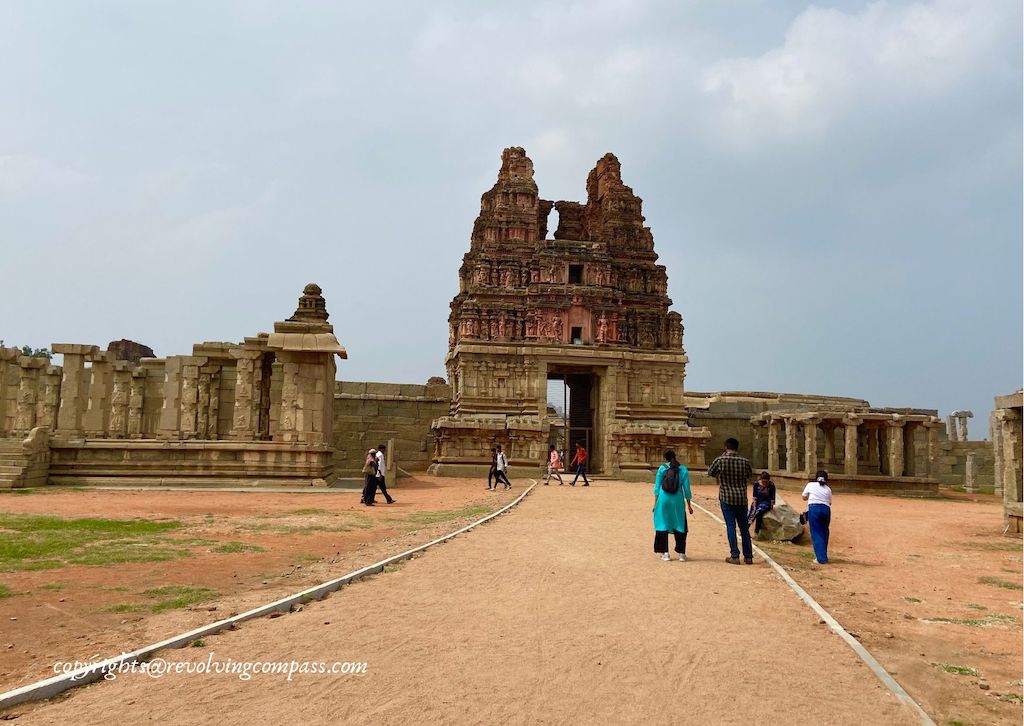
Vittala is a form of Lord Vishnu. As such, Vijaya Vittala Temple is dedicated to Vishnu. As per the inscriptions, it was built around 15th century.
Timings of Vijaya Vittala Temple Hampi
The Vijaya Vittala Temple entry timings are from morning 8:30am to evening 5:30pm all days of the week.
Entry fee to Vijaya Vittala Temple Hampi
INR 40 per Indian adult
INR 500 per foreign adult
Free for kids below 15 years of age
How to reach Vijaya Vittala Temple Hampi
How to drive to Vijaya Vittala Temple
From the highway you can proceed to the Hampi Road, and from there to Vijaya Vittala Temple parking lot as per google maps. Most part of the road is in good condition. Except for the last 100 meters or so to the parking which is little narrow. But the parking area itself is very huge. You can safely park your vehicle here. And then proceed to the temple.
How to walk to Vijaya Vittala Temple

From the parking lot of Vijaya Vittala Temple to the temple main entrance is a 1km walk. If you don’t want to walk, there are electric buggies continuously plying to and fro, offering visitors a ride at INR 10 for a round trip. However, if you can, then I will highly recommend walking as this way, you can see a lot of structures on the way to Vijaya Vittala Temple. Where you can’t stop if you are riding in the vehicle. Read below to know more about these.
There is a trail to walk to Vittala Temple from Virupaksha Temple through the Hampi Bazar near Virupaksha Temple and along the banks of river Tungabhadra. You can take this trail as well.
Here are some of the sites that one can see while walking on a trail along the river Tungabhadra from Virupaksha Temple to Vittala Temple –
- Narsimha Gudi Mandapa
- Sugriva’s Cave
- Sri Kotilinga Temple
- Seetha Pond
- Double Storeyed Mandapa
- King’s Balance
- Vijaya Vittala Temple Hampi
Refer to the below map to see how to navigate from Virupaksha Temple to Vittala Temple –
This is the link to the above map – https://maps.app.goo.gl/pCJw2doZzKdm11U79
From the Parking Lot of Vijaya Vittala Temple to the temple
There is a village road leading from the parking lot of Vijaya Vittala Temple to the main entrance of the temple. Only the designated electric vehicles and special permission holding government vehicles are allowed on this road. You can walk on this road or take the electric buggy to the temple.
For the initial 500 meters of the walk, it is mostly the surrounding green fields and the bouldered mountains beyond them that you will be viewing.
Afterwards, the ruins start, first on the left hand side.
Pushkarani
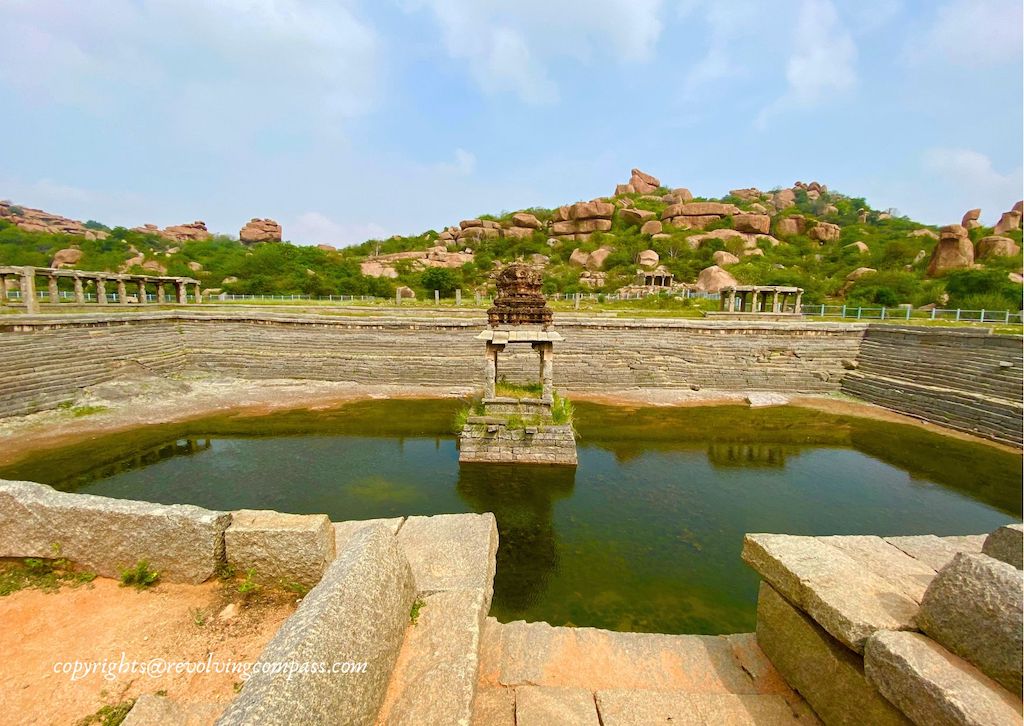
Then a pushkarani on the right hand side. A pushkarani besides a temple was a very common phenomenon in that era. It provided water for ritualistic bathing or taking a cleansing dip before entering into the temple. I have seen such ponds and pushkaranis on my visit to other temples of similar era. Including the temples of Chettinad region, Badami, Pattadakal and Aihole temples and many others.
Vittala Temple Market
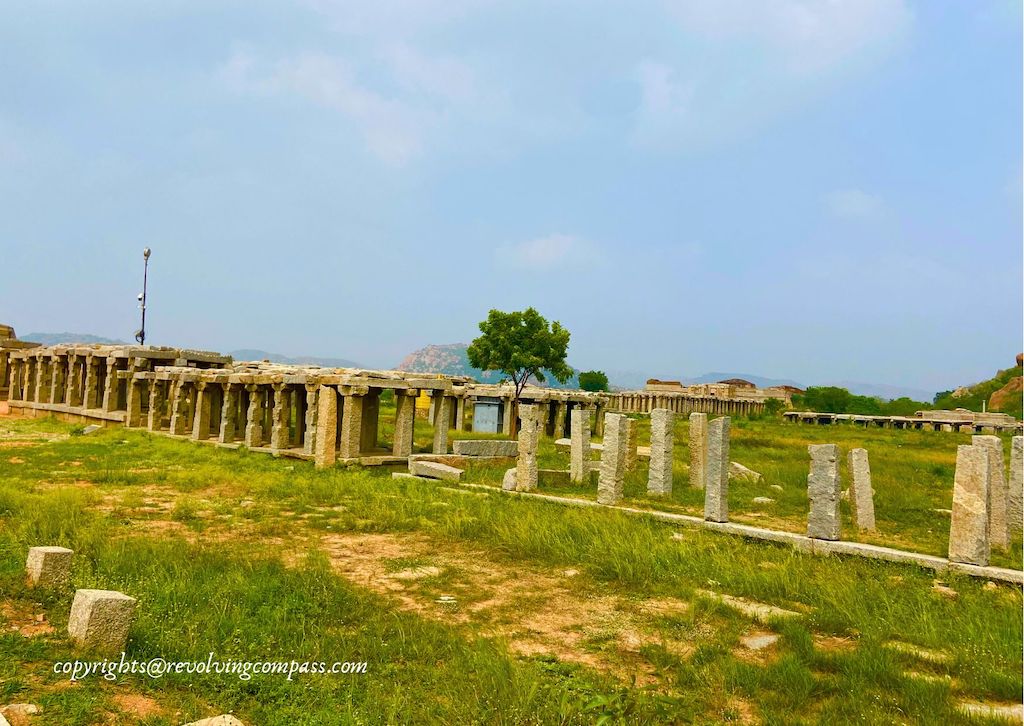
Followed by a shaded area supported by pillars just like many other ruins of markets that you will see in Hampi. So, this must be the starting point of the market that was setup in front of the Vittala Temple. As per our guide, it was one of the grandest market. Where international trade took place with Persian and Portuguese traders.
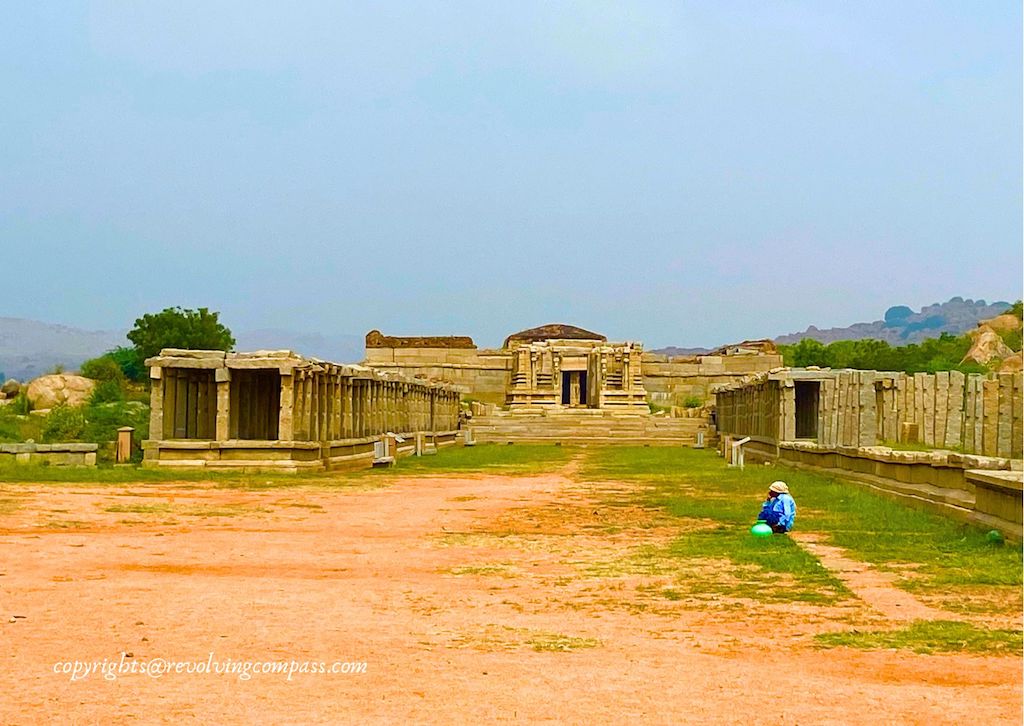
The market setup continues on either side of the temple. While it continues to the side entry of Vittala Temple on the left. At the other end, it continues all the way to the Vishnu Temple on far right.
Main entrance of Vittala Temple
The village road directly ends at the main entrance of Vijaya Vittala Temple. However, this entrance is closed for public as of now. The central part of the gopuram is destroyed. But it still looks grand and beautiful.
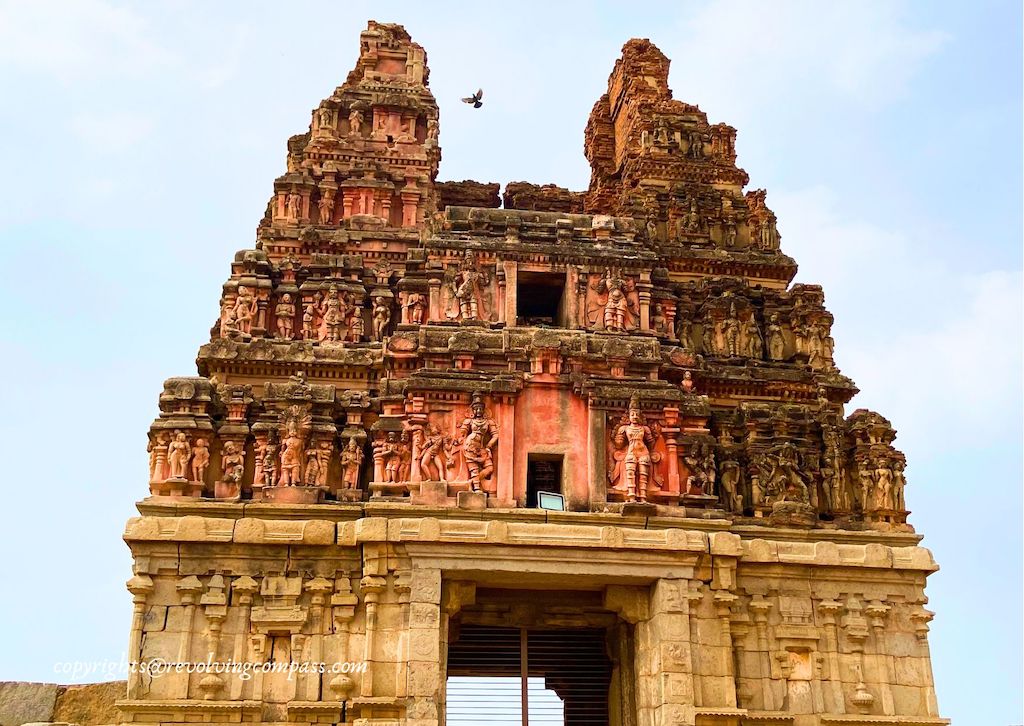
And the left side entrance or eastern entrance is used instead. The ticket counter is in front of this entrance gate. And the electric vehicle also stops here for boarding and de-boarding the visitors.
You might find a long queue at the ticket counter, particularly as the day progresses. Another option is to take a guide with you who will secure an entry for you surpassing the ticket queue. However, the fee of guides are not regulated here. It all depends on your own bargaining skills what deal you are able to strike with the guide.
Architecture of Vijaya Vittala Temple Hampi
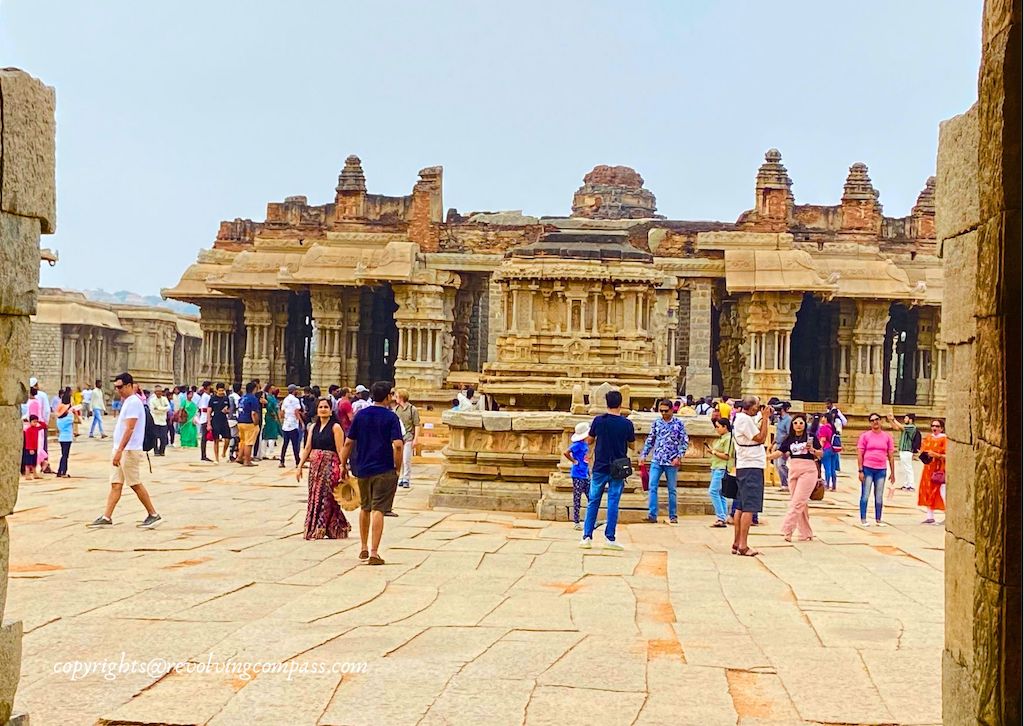
The Vittala Temple is the most grand, most extravagant of all the places to see in Hampi. It has a huge sprawling campus. With several temples and mandapas inside this campus. As you enter inside the main temple, these prominent structures will hold your attention –
The Maha Mantapa of Vittala Temple and it’s carvings
The first thing that catches your attention as you enter inside the Vijaya Vittala Temple is the main and the grandest Maha Mantapa. It is also called Rang Mantapa. The intricate carvings and beautiful designs on this temple are beyond comprehension. As, every single carving is different from the other. And even those which are minute have so much detail to them. Some of these that particularly stand out include –
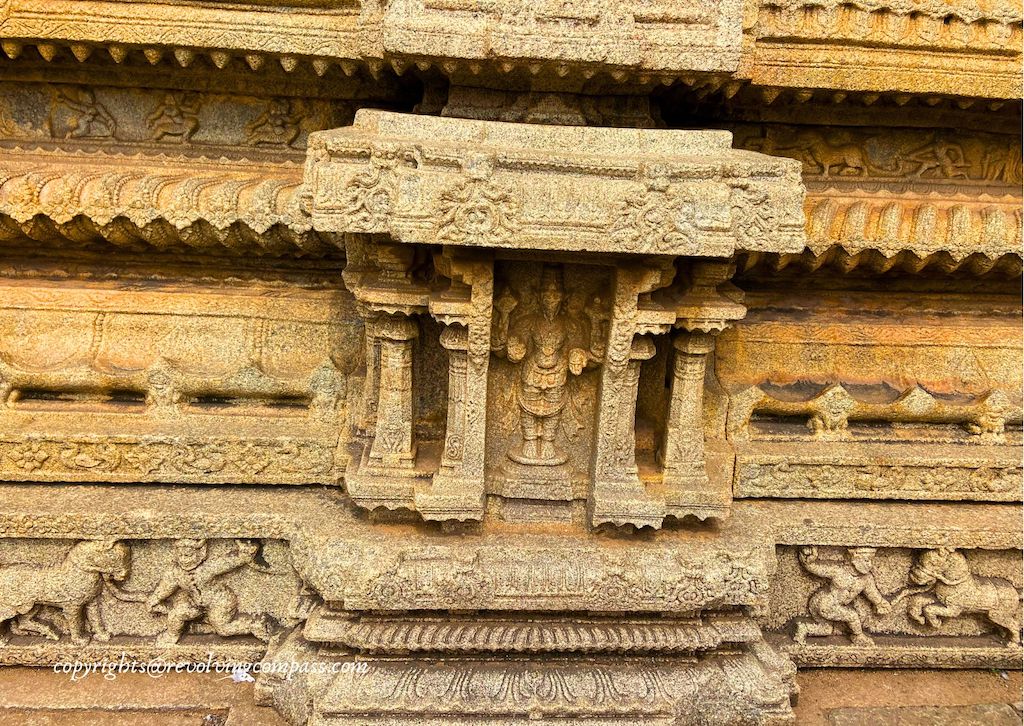
A single figure, which when seen closely from different angles, partially covered with hand depicts different figures like a horse, a frog, a monkey and a lion all in one. Our guide every time hid a different portion with his hand and made us see a few figure – all in one single carving!!
There is also a carving of a miniature temple. Some believe this might have been a prototype to visualise how the main temple would look upon completion.
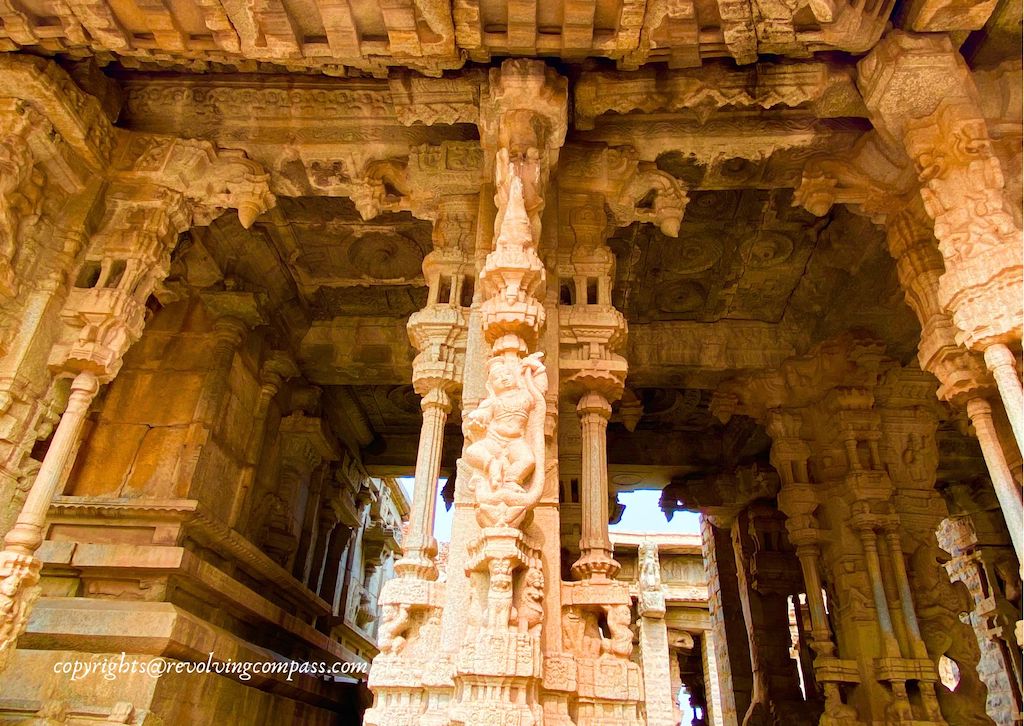
Then there are pictures depicting scenes from Puranas, different forms of Vishnu, dancing women, animals like elephants and horses and so much more.
Musical Pillars in front of the Vittala Temple
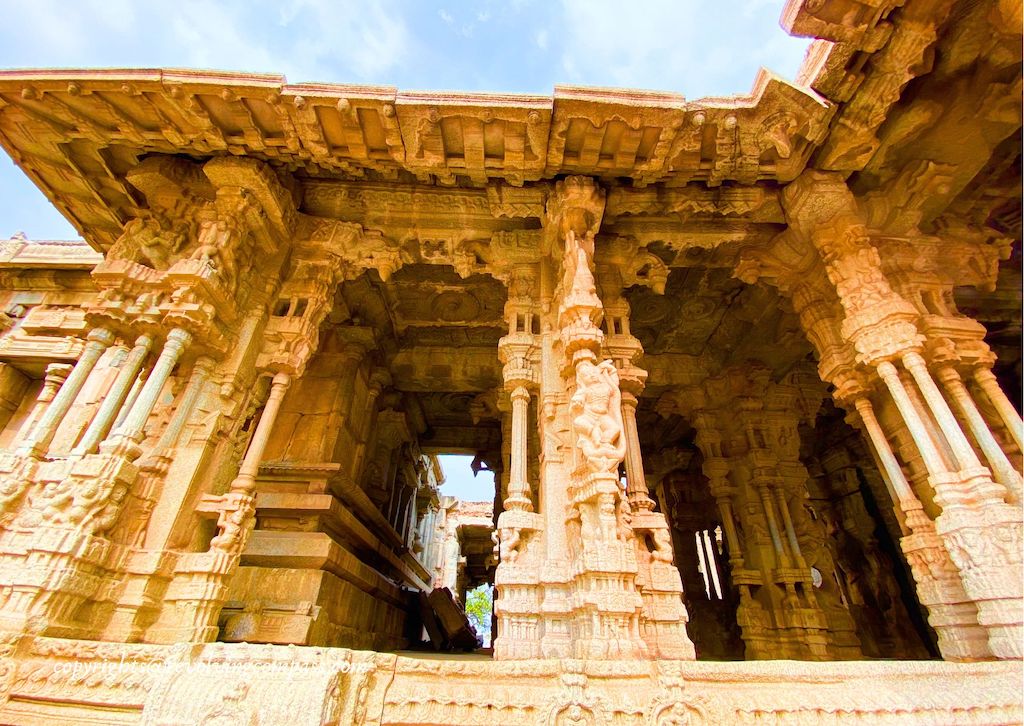
If you look closely, each pillars of the Maha Mantapa are made of several thinner pillars standing together. These pillars are famous as “musical pillars”. As each one of them makes a distinct sound. For instance, the one which has horses carved on it makes dallopping sound of the horses. No one till date could understand how such pillars were created in the first place. They were used to produce music when cultural performances happened in the Maha Mantapa.
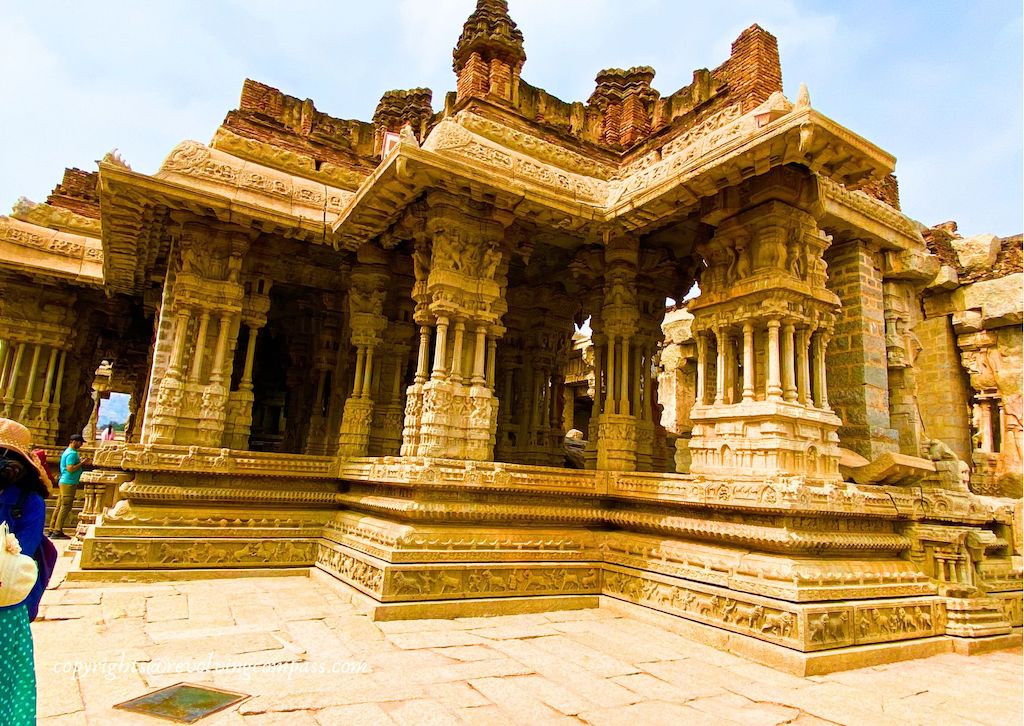
The Stone Chariot of Vittala Temple
Stone Chariot of Vittala Temple is almost the synonym or symbol of Hampi. This is definitely the most iconic structure of Hampi. What is interesting is the fact that it appears to be carved out of a single monolithic block of rock. But actually, it is made of several pieces. But these pieces are so brilliantly interlocked. And the interlocking is hidden in the carvings and decor that it is impossible to locate them. Thus overall it appears to be a carving out of a monolith. These intricate works on the pillars and body of the chariot depict stories from puranas.
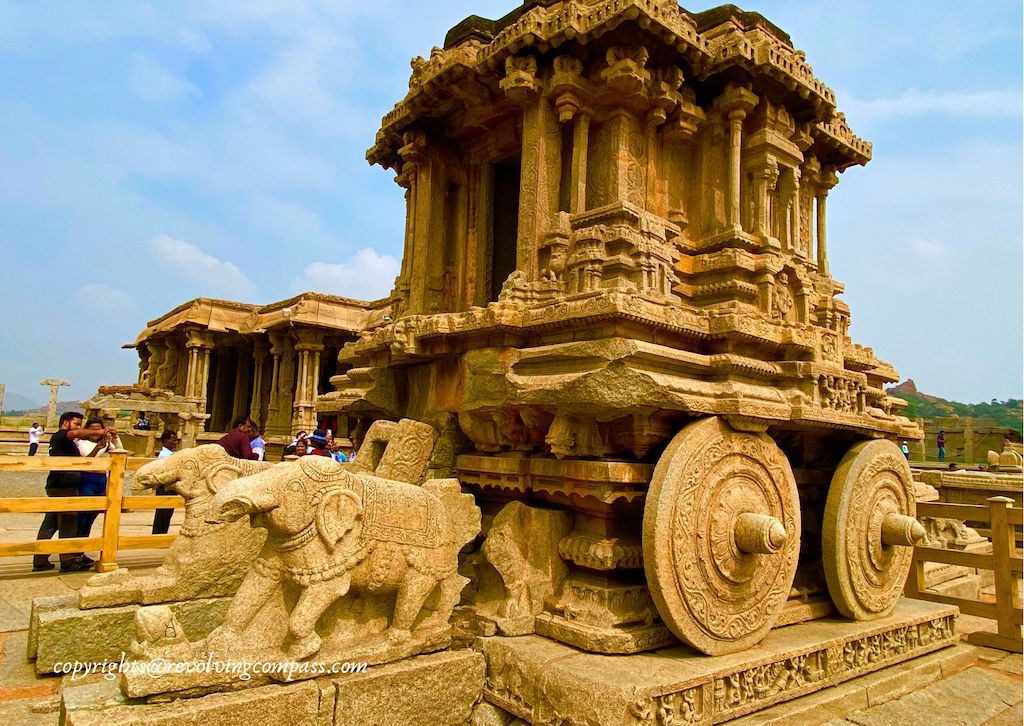
The chariot stands in front of the main shrine of the temple, facing it. The main entrance (which is closed now), the chariot and the shrine all line in one straight line. It is dedicated to Gaduda, the vehicle of God Vishnu.
Underground Shiva Temple inside the campus of Vittala Temple
Behind the main temple is another temple which leads to an underground Shiva Temple. There are many temples in Hampi which are underground. But this one lies within the campus of Vittala Temple. And as such has remained intact along with the rest of the temple. Although it is very dark inside. But is is one of the few underground temples where you can go down. And see the main shrine.
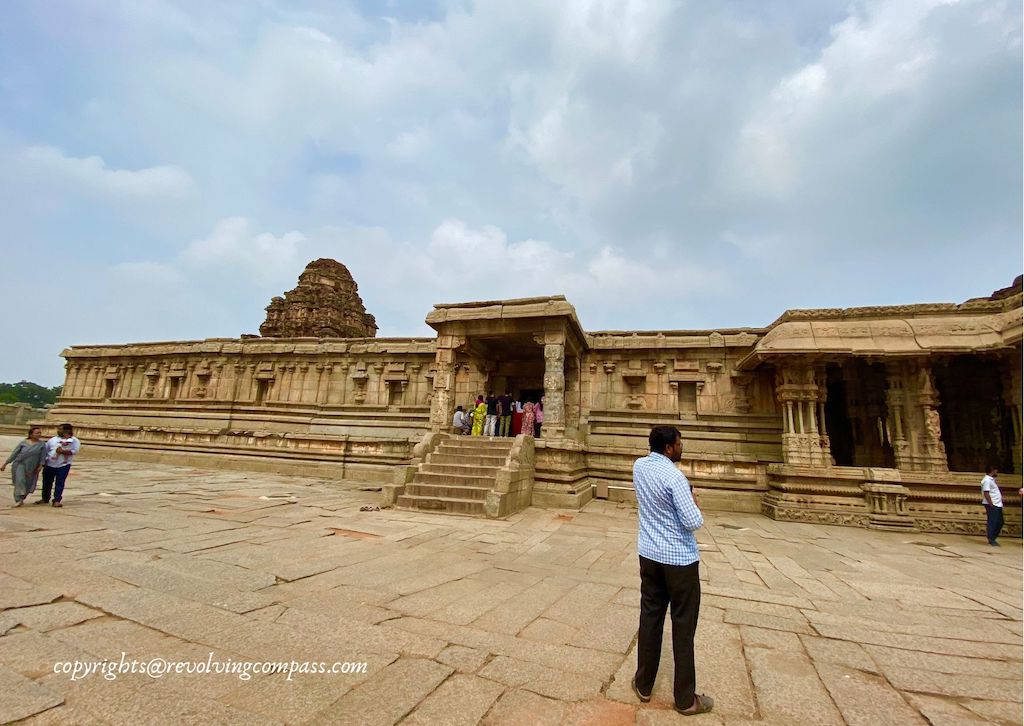
Kalyan Mandapa in Vittala Temple campus
In front of the main temple, on the left side lies a Kalyan Mandapa. Which must have been the place for marriages and rituals. This mandapa is also very intricately carved. It consists of an outer platform that runs on all sides. And an inner square platform that is raised further. Both of these are supported by numerous ornate pillars.
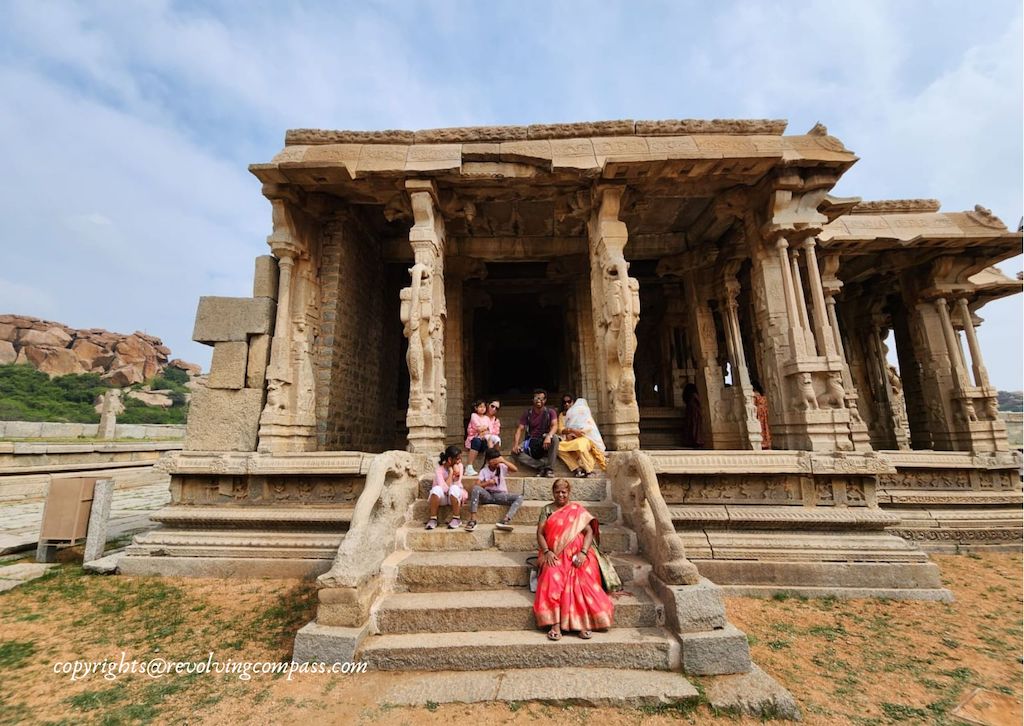
Other information on visiting Vijaya Vittala Temple Hampi
Food options near Vijaya Vittala Temple Hampi
There are any proper food joints near Vijaya Vittala Temple that I could spot. Most of them are located either near the Virupaksha Temple or on the new Hampi side. So, plan your trip accordingly. However, there are some small shops and independent vendors near the parking lot who sell chips, biscuits, water bottles and fresh fruits like watermelon etc.
On our own trip exploring the Vijaya Vittala Temple, we proceeded to Virupaksha Temple from here. And near Virupaksha Temple, we had food at Gopi’s guesthouse. Which was very homely, freshly made and delicious.
How much time is required to visit Vijaya Vittala Temple
Honestly, Vittala Temple itself can consume one whole day if you really want to thoroughly visit it, appreciate the intricate architectural work and understand the importance of each shrines and structures. But, if you have less time, then you should dedicate at least half a day to visit here.
Other places of interest near Vijaya Vittala Temple Hampi
There are many other places of interest near Vijaya Vittala Temple.
It includes –
- King’s Balance – a manual balance on which the king sat on one side and gold or other precious stones equivalent to his weight measured on the other side were donated off to the needy or awarded to the deserving.
- Sugriva’s Cave – the place where Sugriva from Ramayana is believed to have lived
- Ruins along the banks of the Tungabhadra River – there are many ruins as you walk alongside the banks of the river. Many of these remain unidentified.
- Achyuta Raya Temple – Similar to the Hazara Rama Temple that you will see while exploring the Royal Enclosure of Hampi, the Achyuta Raya Temple has some very beautiful carvings. And intricate mural works for you to admire.
General information on visiting Hampi
- Here’s this complete list of accommodations in Hampi. They range from humble homestays to luxury resorts. Some are located very near to the ruins while most others are located in the nearby town of Hospet, almost ~10km from the ruins of Hampi
- You can either drive to Hampi from Bangalore and other nearby towns. Or, hire a local autorickshaw for exploring the ruins of Hampi. Or, get a taxi arranged through your accommodation
- There are also organised tours to Hampi via klook.com and getyourguide.com that will take you to a tour of Hampi from Goa and Aurangabad
- Carry comfortable cotton shoes, comfortable walking shoes, sunglasses, hat and sunscreen lotion as Hampi is a hot destination almost all through the year
- Also carry mosquito repellant.
- Winter months from November to February are best time to visit Hampi. For the rest of the year, when the skies are clouded but it is not raining heavy, that makes for a good time to visit Hampi
- The ruins of Vijayanagara Empire in Hampi are located just 10km from the town of Hospet. Which is well connected with rest of India via road, rail as well as air network. So, you can travel to Hospet and even stay in Hospet to explore Hampi.
- There are plenty of good restaurants in the town of Hospet and around the ruins, particularly Virupaksha Temple and it’s surroundings in Hampi. Which provide all kind of food options.
- Exploring most of the ruins is free of cost. Some like Zenana Enclosure, special darshan at Virupaksha Temple and Vittala Temple have a small entry fee.
Other places to visit in Hampi
Apart from the Vijaya Vittala Temple and it’s surroundings, the following are distinct trails to explore the rest of the ruins in Hampi as well as the banks of river Tungabhadra and the Hippie Island etc. –
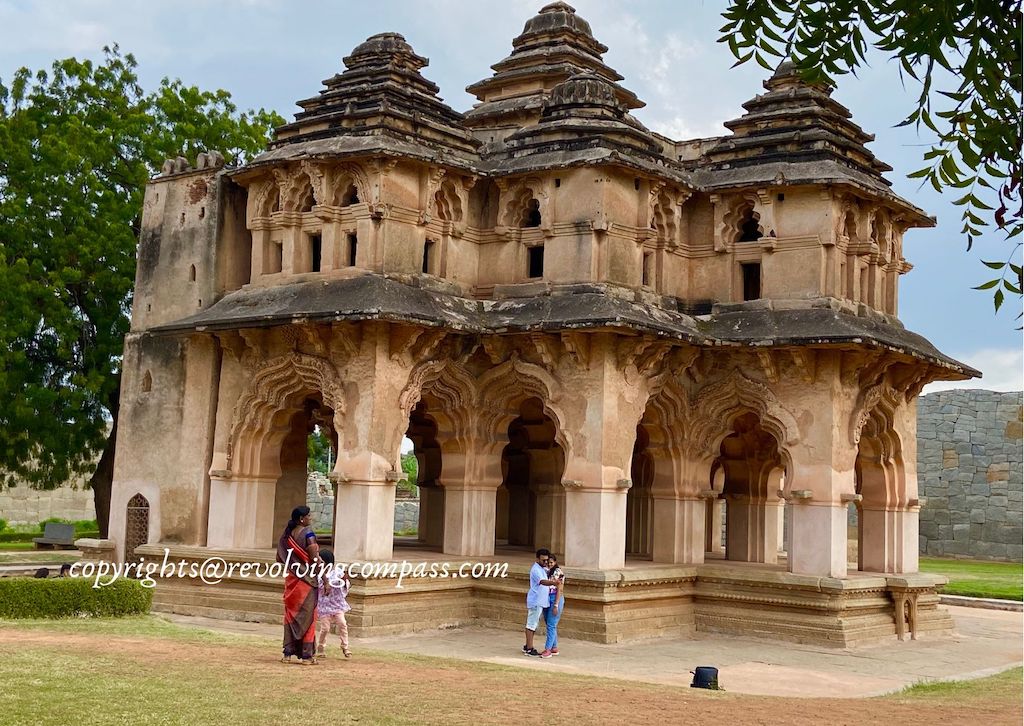
Virupaksha Temple of Hampi and the ruins around it
The Hippie Island across the Tungabhadra river in Hampi
Places to see in Hampi beyond the ancient empire – newly developed parks, dams, riverside cafes etc.
You can visit them in any order. Allocate a minimum of half a day to each region. And if you want to thoroughly explore them, allocate a day to each one.
Other places to visit near Hampi
Chitradurga Fort is a beautiful and massive fort that you can explore on your way from Bangalore to Hampi . It will require a minimum of 2-3 hours to visit Chitradurga Fort.
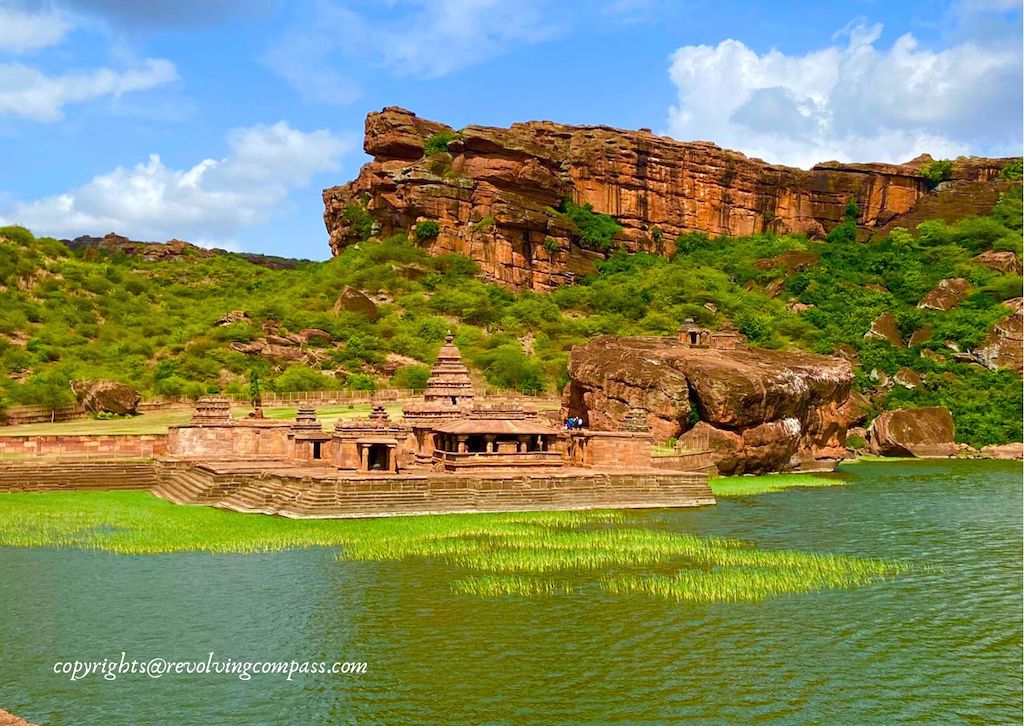
Further 3 hours from Hospete and Hampi lies the trio of Badami, Pattadakal and Aihole – the place known as the cradle of temple architecture in India. The beauty of the sandstone temples here will definitely blow your mind away. We visited the Badami Cave Temples, the UNESCO World Heritage temple complex of Pattadakal and the Temple Complex of Aihole earlier this year on a separate trip. However, you can easily combine a trip to Hampi with one to Badami, Pattadakal and Aihole as well.
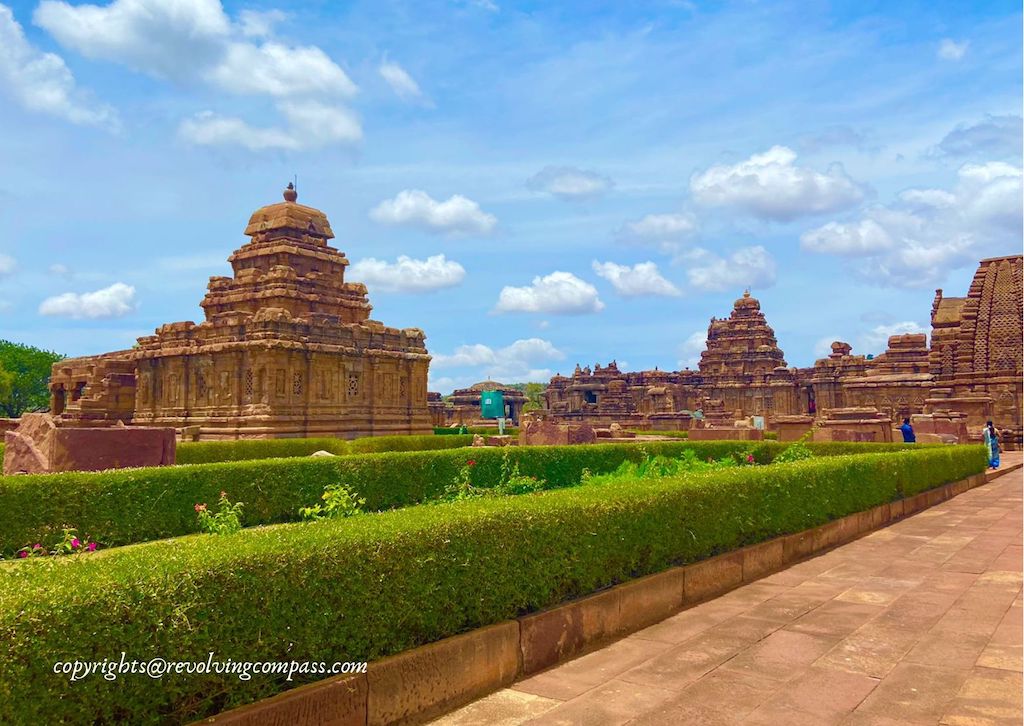
Together, a trip to all these places will take a minimum of 1 week time.
Last, but not the least, here’s our complete guide to explore Hampi with all the information you need to plan a trip to Hampi. Including our suggested trip itinerary to Hampi, Badami, Pattadakal and Aihole.
PS: Some of our links are affiliated, this means we will earn a commission when you buy a service or product by clicking those links. However, this will have no extra cost for you.
